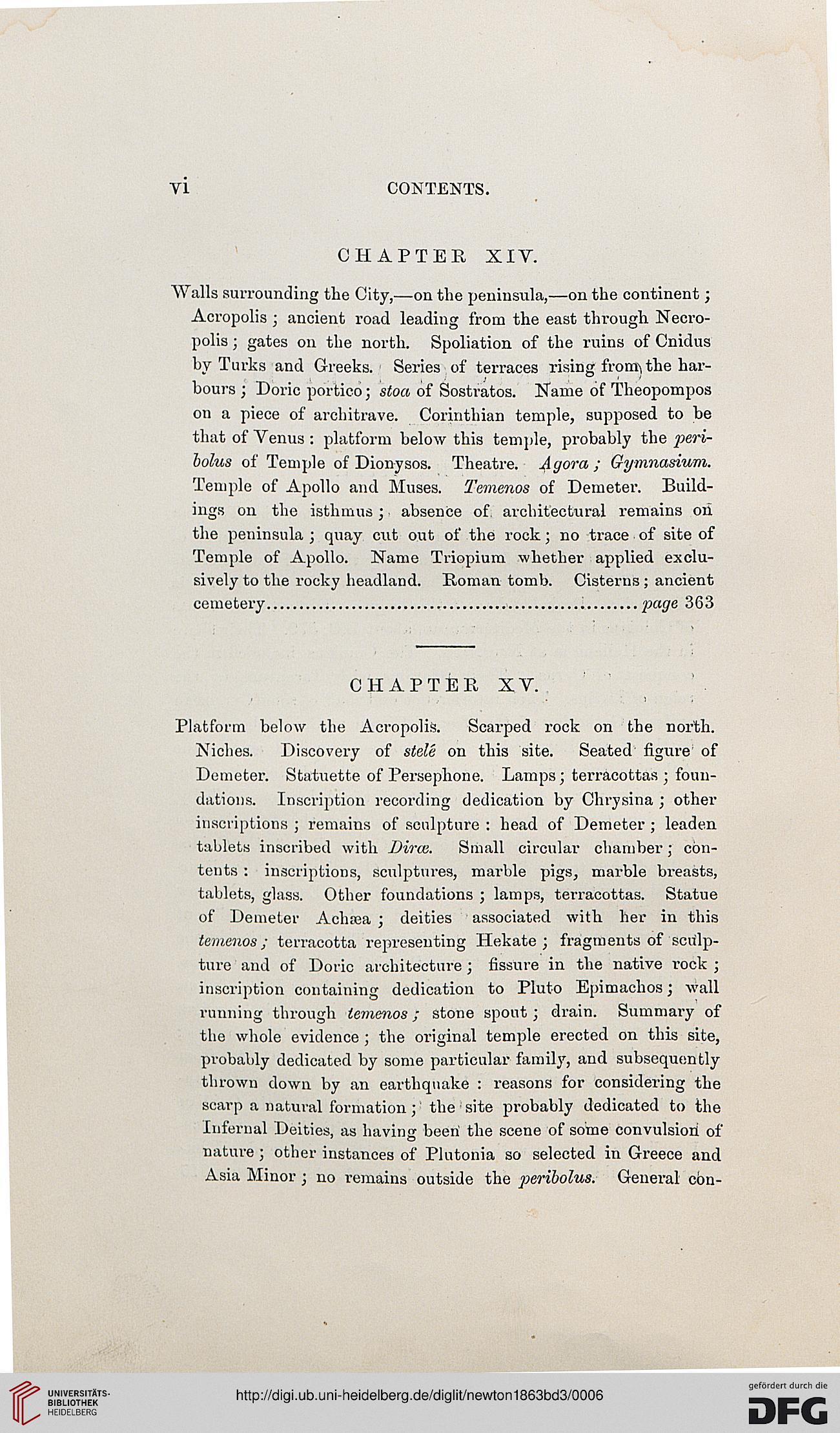VI CONTENTS.
CHAPTER XIV.
Walls surrounding the City,—on the peninsula,—on the continent;
Acropolis ; ancient road leading from the east through Necro-
polis ; gates on the north. Spoliation of the ruins of Cnidus
by Turks and Greeks. Series of terraces rising front the har-
bours ; Doric portico; stoa of Sostratos. Name of Theopompos
on a piece of architrave. Corinthian temple, supposed to be
that of Venus : platform below this temple, probably the peri-
bolus of Temple of Dionysos. Theatre. Agora; Gymnasium.
Temple of Apollo and Muses. Temenos of Demeter. Build-
ings on the isthmus; absence of architectural remains on
the peninsula ; quay cut out of the rock; no trace of site of
Temple of Apollo. Name Triopium whether applied exclu-
sively to the rocky headland. Roman tomb. Cisterns ; ancient
cemetery.........................................................page 363
CHAPTER XV.
Platform below the Acropolis. Scarped rock on the north.
Niches. Discovery of stele on this site. Seated figure of
Demeter. Statuette of Persephone. Lamps; terracottas; foun-
dations. Inscription recording dedication by Chrysina ; other
inscriptions ; remains of sculpture : head of Demeter ; leaden
tablets inscribed with JJirw. Small circular chamber; con-
tents : inscriptions, sculptures, marble pigs, marble breasts,
tablets, glass. Other foundations ; lamps, terracottas. Statue
of Demeter Achrea ; deities associated with her in this
temenos; terracotta representing Hekate ; fragments of sculp-
ture and of Doric architecture ; fissure in the native rock ;
inscription containing dedication to Pluto Epimachos; wall
running through temenos; stone spout ; drain. Summary of
the whole evidence ; the original temple erected on this site,
probably dedicated by some particular family, and subsequently
thrown down by an earthquake : reasons for considering the
scarp a natural formation ; the site probably dedicated to the
Infernal Deities, as havine been the scene of some convulsion of
nature ; other instances of Plutonia so selected in Greece and
Asia Minor ; no remains outside the peribolus. General con-
CHAPTER XIV.
Walls surrounding the City,—on the peninsula,—on the continent;
Acropolis ; ancient road leading from the east through Necro-
polis ; gates on the north. Spoliation of the ruins of Cnidus
by Turks and Greeks. Series of terraces rising front the har-
bours ; Doric portico; stoa of Sostratos. Name of Theopompos
on a piece of architrave. Corinthian temple, supposed to be
that of Venus : platform below this temple, probably the peri-
bolus of Temple of Dionysos. Theatre. Agora; Gymnasium.
Temple of Apollo and Muses. Temenos of Demeter. Build-
ings on the isthmus; absence of architectural remains on
the peninsula ; quay cut out of the rock; no trace of site of
Temple of Apollo. Name Triopium whether applied exclu-
sively to the rocky headland. Roman tomb. Cisterns ; ancient
cemetery.........................................................page 363
CHAPTER XV.
Platform below the Acropolis. Scarped rock on the north.
Niches. Discovery of stele on this site. Seated figure of
Demeter. Statuette of Persephone. Lamps; terracottas; foun-
dations. Inscription recording dedication by Chrysina ; other
inscriptions ; remains of sculpture : head of Demeter ; leaden
tablets inscribed with JJirw. Small circular chamber; con-
tents : inscriptions, sculptures, marble pigs, marble breasts,
tablets, glass. Other foundations ; lamps, terracottas. Statue
of Demeter Achrea ; deities associated with her in this
temenos; terracotta representing Hekate ; fragments of sculp-
ture and of Doric architecture ; fissure in the native rock ;
inscription containing dedication to Pluto Epimachos; wall
running through temenos; stone spout ; drain. Summary of
the whole evidence ; the original temple erected on this site,
probably dedicated by some particular family, and subsequently
thrown down by an earthquake : reasons for considering the
scarp a natural formation ; the site probably dedicated to the
Infernal Deities, as havine been the scene of some convulsion of
nature ; other instances of Plutonia so selected in Greece and
Asia Minor ; no remains outside the peribolus. General con-




